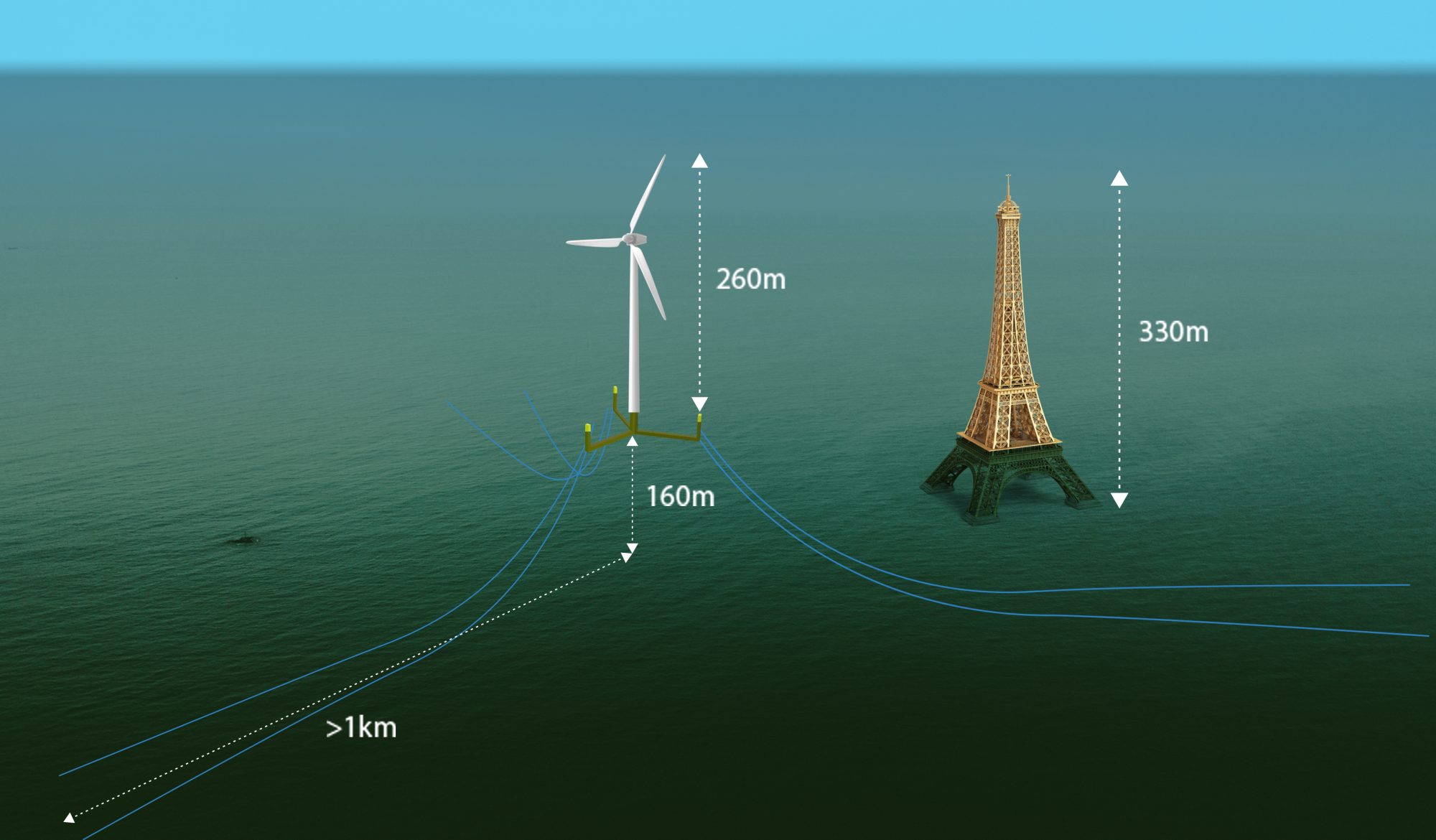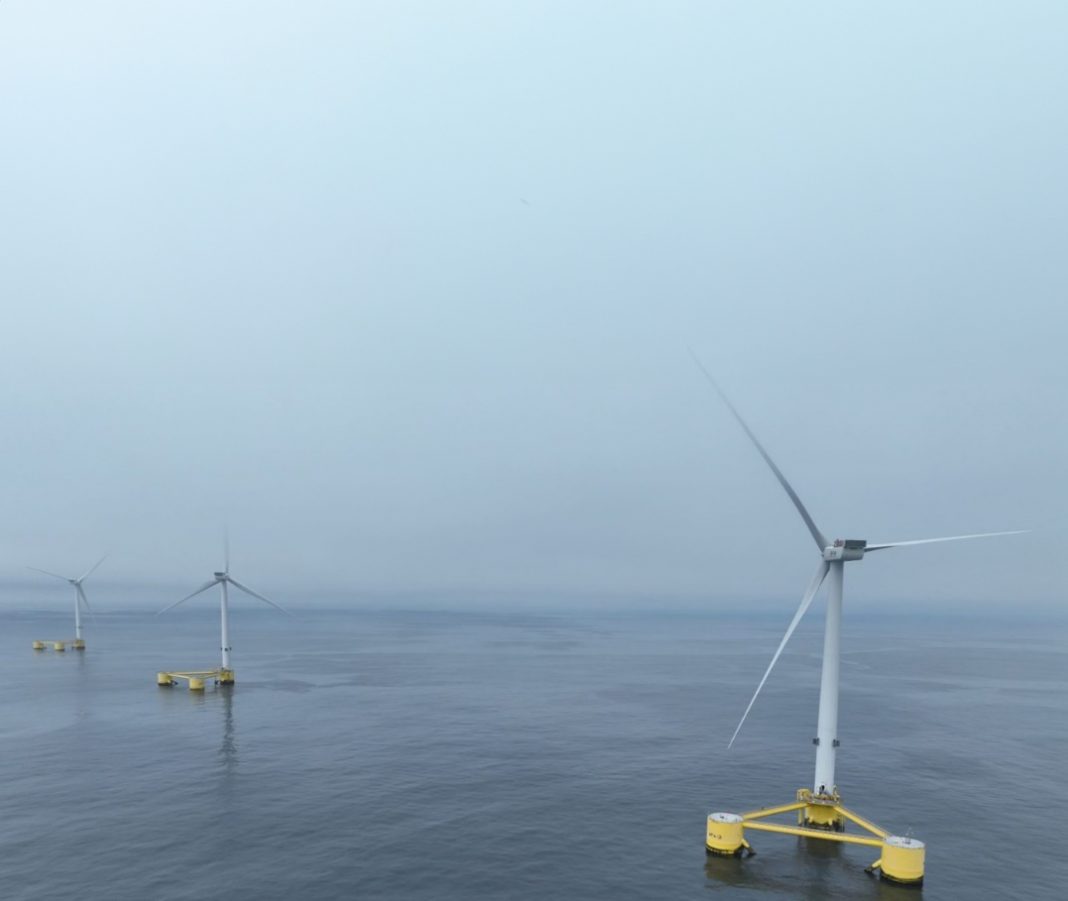TFI Marine places sustainable marine technologies and innovation under the spotlight, starting with a look at floating offshore wind
Floating offshore wind
We are on the cusp of a step-change in our ability to unlock previously untapped potential in offshore renewable energy, enabled by technology advances, including a new offshore mooring solution developed by TFI Marine – the SeaSpring – which opens up enormous possibilities for floating offshore wind energy.
Wind is a significant global power source and a proven clean energy source, with offshore wind growing rapidly over the past 20 years. In 2022, 39.4% of net electricity generated by the EU was renewable energy, with 15.9% of that wind energy.
To deliver more renewable energy, we need to use sites further offshore. Most waters around our continents are too deep for existing fixed-bottom offshore wind solutions, so floating platforms are required.
Floating platforms supporting wind turbines are currently secured to the seabed using traditional Oil & Gas mooring systems.
Further away from the coast, turbines can be larger due to higher wind resources, with next-generation turbines being the size of the Eiffel Tower.

Need for innovation
The job of the mooring system is to keep the platform in place. A typical mooring system consists of three to six mooring lines per platform, each stretching out over 1km in length to an anchor, resulting in a large seabed footprint.
Larger turbines, bigger floating platforms, and increased storms from climate change all cause higher forces on mooring systems.
Existing systems solve this problem by increasing size and weight, resulting in high cost and low sustainability. Seabed chains cause scouring to the seabed, which harms the environment. Other marine users, such as fishermen, are therefore excluded from such sites. New mooring innovations are required.
EU leadership
The EU has taken a lead role in innovation in this space. Through its RePowerEU strategy, Green Deal and Offshore Wind SET Plan, it has set clear goals and targets, supporting UN Sustainable Development Goals.
It has supported these through FP7, H2020, and Horizon Europe grant funding, focusing on offshore wind and its challenges.
TFI Marine SeaSpring
TFI Marine has risen to this challenge by developing the SeaSpring. This new innovative mooring component changes the way a mooring system responds to loading from the wind and storms.
This 100% recyclable polymer ‘spring’ is designed to deliver the desired performance, which matches the specific needs of each particular wind farm. The SeaSpring changes shape depending on the load, modifying the length of the mooring line.
The desired performance is chosen for each wind farm through substantial computer modelling, verified by physical testing.
Technical impacts of floating offshore wind
Tailoring each SeaSpring to each individual windfarm results in mooring load reduction. The highest loads (in the largest storms) are reduced by ~50%, while the cyclic loads (the minimum to maximum load) are reduced by ~40%.
These impacts also allow for more environmentally friendly mooring options to be considered.

Floating offshore wind: Benefits
Each wind farm developer can choose the balance of impacts which deliver the greatest benefit to their farm.
The load reduction allows for all components in the mooring system, from the anchor to the platform, to be shrunk, reducing cost and raw materials. Smaller, lower-cost vessels can then be used for installation. These benefits drive mooring costs to 50% lower.
The SeaSpring reduces cyclic loads, reducing fatigue damage, a major cause of component failure, extending project lifetimes by years and enhancing sustainability.
Combining these benefits can reduce the Levelized Cost of Energy (and the price the consumer pays) by 5-7%.
Environmentally friendly mooring configurations can eliminate seabed interactions, reducing environmental impact. They can reduce mooring footprint by over 80%, allowing co-sharing of the environment with other users (e.g. fishermen, aquaculture, floating solar, marine life).

Development
TFI Marine has developed these components over ten years. Our R&D activities have been supported through multiple EU-funded projects (H2020 Flotec, H2020 Flotant), as well as with some Irish (SEAI, Marine Institute) and US (NOWRDC/NYSERDA Shallowfloat) funding.
Over the past two years, the focus has been on product delivery, new manufacturing processes (the SeaSprings will be the largest injection moulded polymer components in the world), DNV certification (an essential step to being able to sell the products.
TFI Marine was recently awarded an EIC grant to help with this final commercialisation step, supporting factory commissioning, staff training, and industrial product design.
TFI Marine will deliver their first SeaSpring products into floating offshore wind farms in 2026.
TFI Marine Ltd
Tel: +353 (1) 905 2190
Paul.McEvoy@tfimarine.com
http://www.tfimarine.com/about-us

This work is licensed under Creative Commons Attribution-NonCommercial-NoDerivatives 4.0 International.


